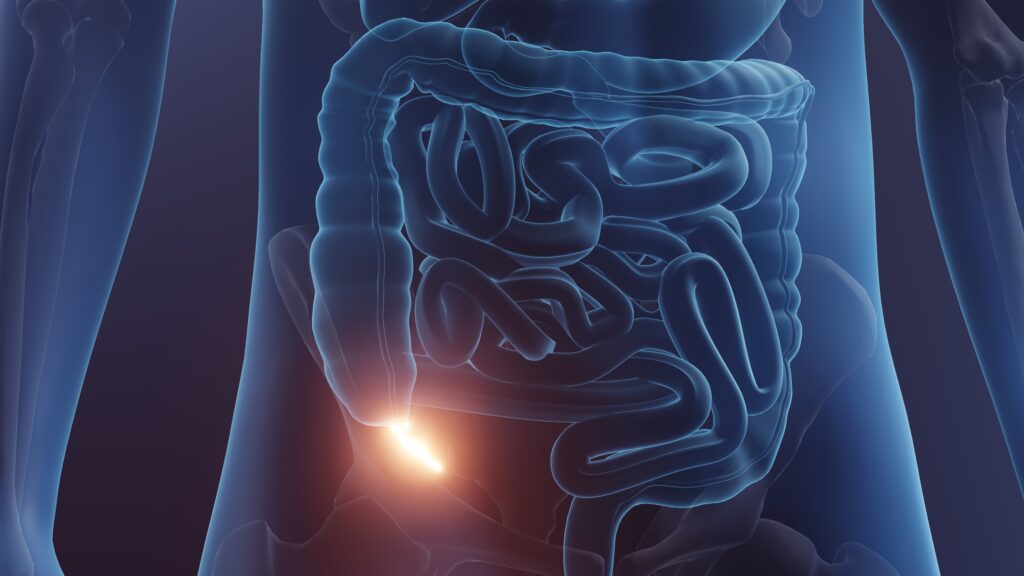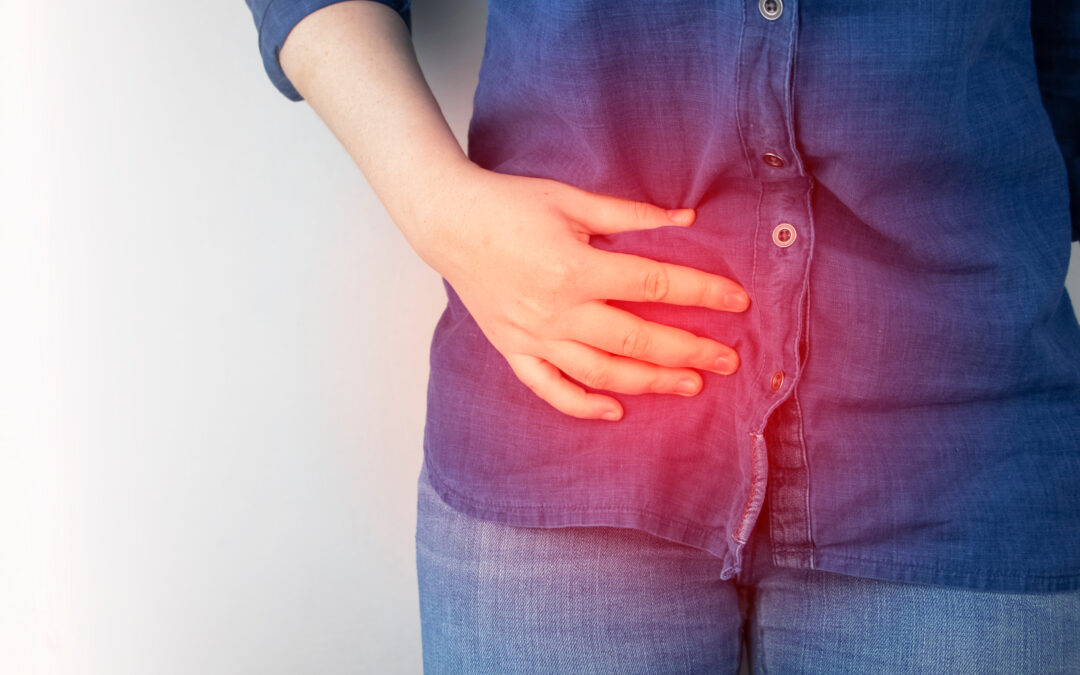An appendectomy becomes necessary when appendicitis, the inflammation of the appendix, poses a risk of rupture—which can sound scary! However, appendectomies are fairly common procedures, with almost 280,000 performed yearly in the U.S. with a low complication rate. Most appendectomies are emergency procedures, as an inflamed appendix can lead to painful consequences if left untreated or ruptured.
Recognizing early symptoms of appendicitis, like severe abdominal pain, nausea, and fever, is crucial. Since education is power, our team at The Surgical Clinic wants to guide you through when an appendectomy is necessary, recognizing symptoms and recovery tips, for a quicker return to everyday life.
What are the Symptoms of Appendicitis?
Your appendix is a small organ attached to your large intestine. The purpose of your appendix is to produce and keep good microbes for your gut. When the appendix becomes infected and inflamed, it leads to appendicitis.
Appendicitis often starts with lower right abdominal pain that initially feels like a dull ache around the belly button. In addition to this intense pain, you may experience:
- Nausea
- Vomiting
- Loss of appetite
- Worsening pain with movement
- Fever
These symptoms can be particularly distressing and uncomfortable, making it difficult to go about normal day-to-day activities like work or school.
However, the symptoms of appendicitis can vary, especially among different age groups. In children, lower right abdominal pain is not the only symptom, but also:
- Painful or frequent urination
- Irritability
- Nausea
- Vomiting
- Walking with a limp
- Pain when moving
- Constipation
- Diarrhea
Appendicitis symptoms in the elderly are similar to those in adults, such as pain in the lower right abdomen, in addition to:
- Severe tenderness
- Shifting pain
- Low appetite
- Nausea
- Vomiting
- Fever
As the infection worsens, symptoms are likely to become more intense, requiring immediate medical care or assistance.

Causes and Risk Factors for Appendicitis
What usually causes appendicitis is an infection and inflammation of the small organ, which is typically due to a blockage in the appendix.
Blockages can be:
- Harden stool
- Undigested food
- Parasite(s)
- Bacteria
- GI ulcers
- IBS
- Trauma to the appendix
Anyone can get appendicitis, but there are a few risk factors to keep in mind such as:
- Family history
- Gender, as men have a higher risk than women
- Between the ages of ten and thirty
- Low fiber diet
- Constipation
- Smoking
Diagnosing Appendicitis
The process of diagnosing appendicitis typically begins with a physical exam, where the doctor may press on the lower right abdomen and release quickly to see if the pain worsens, a classic sign to diagnose appendicitis. Abdominal guarding, where the abdominal muscles flex in response to pressure, may also be observed.
Blood tests are often conducted to check for signs of infection, such as a high white blood cell count. Imaging tests, including abdominal X-rays, ultrasounds, or CT scans, may be used to confirm appendicitis or rule out other causes of abdominal pain. In some cases, a pelvic exam might be necessary, particularly for women of childbearing age, to exclude other potential sources of pain.
Early diagnosis of appendicitis is crucial to prevent severe complications, such as a ruptured appendix. A ruptured appendix can lead to severe complications, including peritonitis, an infection of the abdominal cavity that can be life-threatening. With this in mind, it is paramount to contact your medical provider if you believe you are experiencing symptoms of appendicitis.

What Is an Appendectomy?
The gold standard for treating appendicitis is through a surgical procedure known as an appendectomy.
There are two main types of appendectomy: laparoscopic and open. The choice between these procedures depends on the specific case and the surgeon’s recommendation. Laparoscopic appendectomy generally offers a quicker recovery and less postoperative pain, making it the preferred option for many patients.
However, in certain situations, such as a burst appendix, emergency surgery may be necessary.
Laparoscopic Appendectomy
Laparoscopic appendectomy involves making several small incisions in the abdomen to access and remove the appendix. This minimally invasive procedure is performed under general anesthesia and typically results in less postoperative pain compared to open surgery. The risk of wound infection is also significantly lower, and patients usually experience a quicker return to normal activities.
The benefits of laparoscopic appendectomy are numerous, including:
- Faster recovery
- Less scarring
- Reduced pain
Patients can usually resume their daily routines a few days earlier than those who undergo open surgery, making it an attractive option for treating appendicitis. Despite these advantages, the choice of procedure will depend on the specific circumstances and stage of appendicities.
Open Appendectomy
An open appendectomy is often necessary when the appendix has burst or in cases of complicated appendicitis, which usually requires emergency abdominal surgery. This procedure involves making a larger incision in the lower right abdomen to remove the appendix.
While recovery may take longer compared to laparoscopic surgery, it is sometimes the best option to ensure all infected tissue is removed and complications are minimized.
Both laparoscopic and open appendectomies typically last an hour.
How to Prepare for an Appendectomy
While most appendectomy surgeries are not planned in advance, as they are typically emergency procedures, there are a few things to bring to be prepared for surgery. If you do anticipate that you will be visiting your local emergency room for an appendectomy, be sure that there is someone you can bring with you to drive you to and from the hospital. If you can, consider packing loose fitting clothes, your photo ID, insurance card, and a possible medication list.
You will also want to follow any protocols that your doctor shares prior to surgery. Sometimes your provider may suggest not eating food prior to surgery, undergo further testing, and empty your bladder. Doing so will help ensure your surgery is successful, and can set you up for a seamless recovery.
Be sure you have someone who is able to drive you home following your surgery, as it can take up to a week before you can drive after an appendectomy.

Recovery from an Appendectomy Surgery
Following an appendectomy, you will most likely need to stay in the hospital for one to two days, depending on which type of appendectomy surgery, for pain management and nurse supervision. Following your discharge from the hospital there are a few guidelines to follow to ensure you heal fully and optimally.
Pain Management at Home
Effective pain management is essential for a comfortable recovery after an appendectomy. Your provider will provide you with what a pain management schedule can look like for you once you return home. Typically, pain following an appendectomy can be managed with the help of over the counter pain relievers like Tylenol or Advil. You can also expect bruising and feeling sore after this procedure, especially at the incision site.
Rest and Activity
Adequate rest is also a key player in your recovery, as it helps the body to further heal. It will be normal to feel tired following an appendectomy, so be sure to get as much rest and sleep as you need. During your recovery time, it is important to avoid any strenuous activities for about two weeks, as these activities could negatively impact your healing. As you heal, you will slowly recover your energy. When you feel ready, it can be helpful to go for light walks, which can promote blood flow.
You can expect to go back to work or school in one to three weeks, depending on how you’re feeling and if the incision site is healed.
Diet
During your recovery time, it will also be normal for you to experience a decrease in appetite. However, it is important that you eat the right nutrients to promote healing. Doctors typically suggest that you eat a bland, easy to digest diet (similar to the BRAT diet) in the days following an appendectomy. Types of food to look for include:
- Liquid foods like bone broth
- Lean proteins like skinless chicken and eggs
- Soft fruits like bananas
- Toast
- Applesauce
Over time, you will slowly gain back your appetite, but go slow with the foods you reintroduce following your procedure as you continue to heal.
As always, it is best to consult with your doctor regarding what diet to follow and when you can return to physical activities, work, or school.
Post-Appendectomy Follow-Up Appointment
About four weeks following your appendectomy, you will have a follow-up appointment with your surgeon to monitor your healing progress and address any post-surgery concerns. During this appointment you can expect to review your recovery progress and discuss any issues or questions you may have.
Signs of Complications Following an Appendectomy
While complications from a laparoscopic appendectomy are rare, they can occur. Potential issues include:
- Bleeding
- Infection
- Hernias
- Blood clots
- Heart problems
If you notice symptoms such as severe pain, increased redness, swelling, or discharge at the incision site, contact your doctor immediately. Monitoring your recovery closely and being aware of potential complications can help ensure a swift and safe return to health.
Appendectomy FAQs
Can You Live Without Your Appendix?
Yes, you can live without your appendix because its function is not essential to the entire body. In fact, some people are born without an appendix, due to a rare condition, and lead normal, healthy lives.
How Can I Prevent Appendicitis?
While appendicitis is not completely preventable, there are proactive measures you can take to decrease your risk of having an inflamed or infected appendix. Some ways to help prevent appendicitis include:
- Eating foods high in fiber
- Include fermented foods in your diet
- Limiting processed foods or sugar intake
- Share with your doctor if you’re experiencing consistent constipation
What Happens to Untreated Appendicitis?
If appendicitis is not properly treated, then it can cause your appendix to burst, creating further complications. Once your appendix bursts it can lead to peritonitis, which can be life-threatening.
Can You Have Appendicitis While Pregnant?
Yes, appendicitis can occur during pregnancy, especially during the first two trimesters. If you are pregnant and experiencing what you believe to be appendicitis, contact your medical provider immediately.
Conclusion
Ultimately, understanding appendicitis and its treatment options is crucial for effective management and recovery. Recognizing symptoms early, seeking timely medical attention, and following recovery guidelines can help ensure a smooth and safe return to health. Stay informed and proactive to navigate this medical emergency with confidence.
To compassionately guide you through the entire appendectomy process, we have skilled surgeons at The Surgical Clinic in Nashville, Tennessee, who specialize in abdomen conditions and diagnoses. For additional information about an appendectomy or other abdominal surgery, contact our clinic today.

